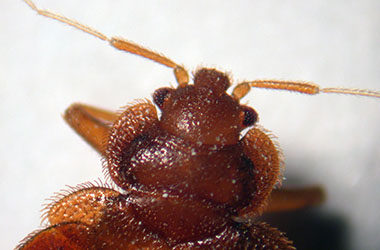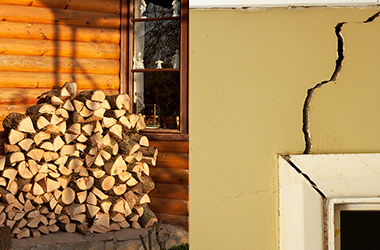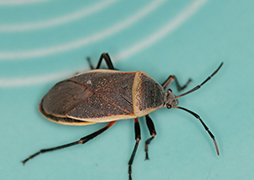Have a Bugs Problem?
Or call us +383(0)49221223
As the North Carolina Panthers keep pounding all the way to Super Bowl 50 and we get ready for Valentines Day, we also need to pay attention to other news that may not be as exciting but definitely very important.
The Center for Disease Control and Prevention (CDC) recently reported finding a deadly insect known as the kissing bug in North Carolina. Actually, kissing bugs have been discovered in 28 states, and as far north as New Jersey. The CDC reported there are 300,000 cases of Chagas Disease in the U.S. so far but most were infected in Latin America where it is most often found. The CDC maintains that the likelihood of contracting the disease in the U.S. is still relatively low but it is important to be aware as sometimes symptoms do not show up for years.
Triatomine, aka kissing bugs
Triatomine include conenose bugs, assassin bugs and kissing bugs. Typically found in Latin America where, in 1909, Brazilian doctor Carlos Chagas discovered that kissing bugs were responsible for the transmission of a parasite, trypanosoma cruzi, to his patients.
Chagas Disease, caused by the trypanosoma cruzi parasite entering the bloodstream, in chronic cases can cause intestinal issues and heart failure. While some victims experience no symptoms, some suffer flu-like symptoms, with vomiting, swollen lymph glands and high fevers. Typically, Romañas sign, which refers to the swelling of an eyelid, occurs in early stages of the disease.
If left undetected or untreated for years, the trypanosoma cruzi parasite can cause chronic disorders in the intestines and break down the heart and the digestive system.
How do triatomine infect humans?
Like bed bugs, ticks and mosquitoes, kissing bugs are little bloodsuckers that feed on human blood. And while bed bugs dont pose serious health threats to humans, kissing bugs carry a parasite in their excrement that can be deadly if left untreated.
However, according to epidemiologists, a kissing bug would have to feed, relieve itself and have its feces be rubbed into the bite wound or an open sore, in order to infect a human being with Chagas. Other ways trypanosoma cruzi can be transmitted include:
- Ingesting infected kissing bug feces in uncooked food
- Blood transfusions
- Mothers can pass the parasite to newborns during pregnancy or childbirth
- Infected donor organ transplants
- Laboratory accidents
The good news: One case out of 900-4,000 contacts with infected kissing bugs in the US results in a case of Chagas Disease. Also, the disease is not transmitted like the cold or flu through casual contact with infected individuals.
What to know about kissing bugs:
Known in Latin America as barbeiros, vinchucas, pitos and chinches, kissing bugs measure about an inch long, with pear-shaped bodies, brown, red or yellow stripes and a pair of transparent wings. Some say they resemble a cockroach.
Adult kissing bugs do fly and during warmer months are attracted to light coming from your home. Like bed bugs, kissing bugs are nocturnal, hiding during the day and coming out at night to feast on humans and pets, attracted by exhaled carbon dioxide, skin odors and body heat. Their bites are relatively painless, usually not waking victims. Kissing bugs feed near the mouth and eyes of their human hosts, hence their name. Their hiding places include:
Outside: Piles of wood objects on the exterior of your home, such as firewood, lumber, tiles, stones, bags of food and animal habitats, like chicken coops and goat corrals.
Indoors: Cracks in walls, crevices in beds, behind pictures, in furniture crevices, cardboard boxes and hanging clothing near their food sources.
Kissing Bug Control
No vaccination exists for Chagas Disease, but in the initial stages of the disease, benznidazole and also nifurtimox have shown to be highly effective, but the effects of these anti-parasitic drugs diminish the longer a person is infected. The drugs are also not FDA approved in the U.S. and are only available from the CDC and both drugs have some fairly common side effects.
The best prevention plan for kissing bugs is exclusion, guarding your home against entry. Truly Nolen Charlotte suggests a few guidelines to follow in excluding kissing bugs and other pests from your home.
- Seal all cracks, gaps and holes around foundations, crawlspaces, windows, walls, roofs and doors.
- Eliminate clutter outside and indoors, especially in bedrooms.
- Eliminate wood and rock piles near your house.
- Stack firewood at least 20 ft. from your home.
- Install screens on doors and windows. Repair existing screen holes or tears.
- Seal gaps and holes leading to your attic.
- Keep pets indoors overnight.
- Clean your home regularly, vacuuming and sweeping often.
- Sanitize outdoor pet areas and indoor pet beds and periodically check areas for bugs.
- Practice safe and sanitary food preparation, consumption and storage measures.
Contact a professional
Because commercial pesticides do not eradicate kissing bugs, should you find a kissing bug, do not squash it or touch it with your bare hands. The CDC recommends placing a plastic bag over your hand to pick the bug up. Deposit kissing bug in a container, then drown it with rubbing alcohol or freeze the bug in water. Anything the kissing bug has come into contact with should be thoroughly cleaned with a bleach solution.
With so many new pests emerging, it is best to contact a professional pest control company, like Truly Nolen Charlotte, to inspect your property for kissing bugs and all pests and devise an effective exclusion, reduction and prevention plan of action. Call Truly Nolen Charlotte at (704) 910-2936 to schedule an inspection.


